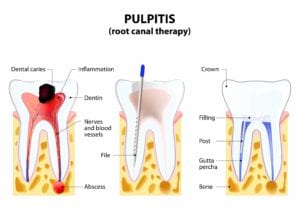ROOT CANALS NEAR YOU
Root canals are restorative dental procedures used as a last resort to save a severely decayed tooth. They become essential when the innermost pulp layer has become infected and are performed to prevent the infection from spreading. During a root canal, the infected and decayed tissue is removed from the inside of the tooth. The tooth is then restored by having a dental crown placed in order to protect it.Did You Know?
When the pulp layer becomes infected, this is called pulpitis. Pulpitis causes the inside of the tooth to eventually die, which leads to decayed tissue being contained within the tooth. This can cause the tooth to appear grey or black in color.
Frequently Asked Questions:
Do I need a root canal?

How are root canals performed at my Kamloops dental office?
First and foremost, all our root canals are performed with dental anesthetics and the option of dental sedation in varying levels. Prior to your root canal appointment, you can discuss the possibility of dental sedation, as well as which level of sedation is best for you. Root canals will only begin once the dental anesthetic is actively making your mouth numb to ensure your comfort. To access the inside of your tooth, a dental drill will be used to make a small access hole in the top of your tooth. The remainder of the procedure will be performed through this hole. Once inside the tooth, the decayed and infected tissue will be removed from the pulp chamber and root canals using different sizes of root canal files. Depending on how small and curved your root canals are, this step may take awhile while your dentist carefully cleans out the root canals. After removing all the decayed and infected tissue, the remaining chamber and canals will be flushed with a microbial solution to reduce the risk of developing decay in the future.


